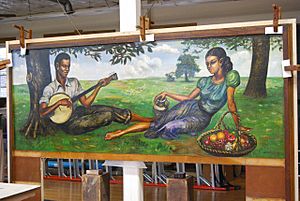Samuel A. Countee facts for kids
Samuel A. Countee (born April 1, 1909 – died September 11, 1959) was a talented American painter and sculptor. He created many artworks that showed what life was like for African Americans. A building at Fort Leonard Wood called SSG Samuel A. Countee Hall is named after him to honor his contributions.
Contents
Early Life and Learning
Samuel A. Countee was born in Marshall, Texas. He went to Booker T. Washington High School from 1924 to 1928.
He loved art and studied it at Bishop College, graduating in 1934. To help pay for his studies, he painted pictures of his teachers and school leaders. After college, he received a special scholarship to the Boston Museum of Arts. There, he worked as an artist living and creating art at the museum.
His Art Career
Samuel Countee's art often showed scenes from African-American life. He shared his work in many art shows between 1933 and 1935.
In 1933, his painting called Little Brown Boy was shown by the William E. Harmon Foundation. His art was also displayed at places like Howard University, Atlanta University, Smith College, and the Institute of Modern Art in Boston. In 1936, his work was featured at the Texas Centennial's Hall of Negro Life.
Art During Military Service
In 1942, Countee joined the United States Army. While serving, he was asked to paint a large mural for the African-American Officers’ Club at Fort Leonard Wood in Missouri. He also painted backgrounds for shows put on by the USO, which entertained soldiers.
After leaving the military, Countee moved to New York City. He became well-known among other artists there. He painted portraits of famous people like Lucille Armstrong, Harry Belafonte, and Marian Anderson.
His Personal Life
Samuel Countee made his home in Long Island, New York. He married Mary Miner in 1955. Sadly, he passed away from cancer on September 11, 1959.
His Lasting Legacy
In 2019, the building at Fort Leonard Wood that holds Countee's mural was officially renamed SSG Samuel A. Countee Hall. This was a way to honor his artistic talent and service.
His niece, Sammie Witing-Ellis, played a big part in making sure people knew her uncle had painted the mural. She found matching drawings in his old sketchbook, which helped prove it was his work.
External Link
- See the Mural at SSG Samuel A. Countee Hall, Fort Leonard Wood


